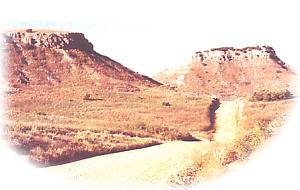
Washita Battlefield National Historic Site protects and interprets the site of the Southern Cheyenne village of Peace Chief Black Kettle that was attacked by the 7th U.S. Cavalry under Lt. Col. George A. Custer just before dawn on November 27, 1868. The controversial strike was hailed at the time by the military and many civilians as a significant victory aimed at reducing Indian raids on frontier settlements. Washita remains controversial because many Indians and whites labeled Custer's attack a massacre. Black Kettle is still honored as a prominent leader who never ceased striving for peace even though it cost him his life.
The overlook consists of a historical plaque, a monument commemorating the site, and a panel indicating the approximate route, approach, and attack of Custer, and the approximate location of the Indian village.
There is a self-guided trail system available that is designed to provide you with a visual experience of the happenings here in 1868. The trail system is divided into two trails that allow you to explore and learn about the action on the Washita. The upper loop is 8/10 of a mile with 7 stops, and the lower loop trail is 7/10 of a mile with 5 stops. The guide can be obtained at the locations listed below.
